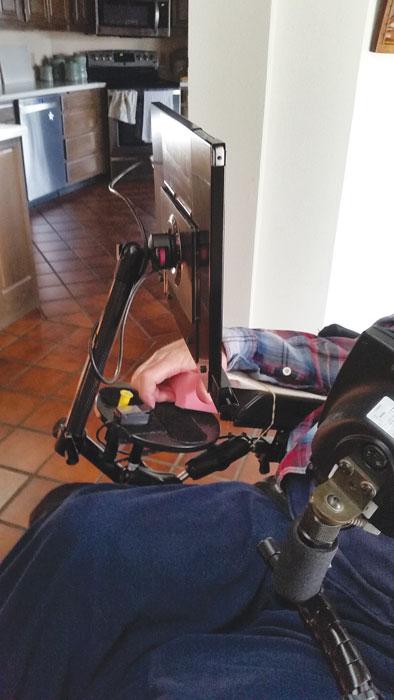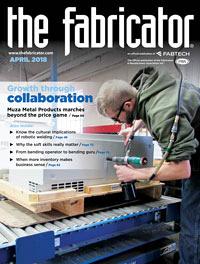- FMA
- The Fabricator
- FABTECH
- Canadian Metalworking
Categories
- Additive Manufacturing
- Aluminum Welding
- Arc Welding
- Assembly and Joining
- Automation and Robotics
- Bending and Forming
- Consumables
- Cutting and Weld Prep
- Electric Vehicles
- En Español
- Finishing
- Hydroforming
- Laser Cutting
- Laser Welding
- Machining
- Manufacturing Software
- Materials Handling
- Metals/Materials
- Oxyfuel Cutting
- Plasma Cutting
- Power Tools
- Punching and Other Holemaking
- Roll Forming
- Safety
- Sawing
- Shearing
- Shop Management
- Testing and Measuring
- Tube and Pipe Fabrication
- Tube and Pipe Production
- Waterjet Cutting
Industry Directory
Webcasts
Podcasts
FAB 40
Advertise
Subscribe
Account Login
Search
Fabricator develops aluminum case to fasten communication system to wheelchair
Fabricated tablet case helps ALS patients communicate, live fuller lives
- By Eric Lundin
- April 13, 2018
- Article
- Bending and Forming
Dealing with amyotrophic lateral sclerosis (ALS, also known as Lou Gehrig’s disease), is anything but easy. Stiff, twitching muscles give way to debilitating muscle weakness. However, the condition doesn’t necessarily render immobile those afflicted with this disease. As the illness progresses, many of the afflicted use wheelchairs for mobility.
Likewise, the condition makes speaking difficult and in many cases impossible, but this doesn’t mean that communication is impossible. A recent development in communication technology, VisuALS, provides the ability to communicate by tracking eye movements. Initiated as a master’s program capstone project by Ash Srinivas, a former engineering student at Oklahoma Christian University, Edmond, Okla., the concept was inspired by a friend who suffered from ALS. Although Srinivas graduated while the system was still in development, a subsequent team of students picked up where he left off and brought it to market. By combining a tablet computer with an eye-tracking system and writing the appropriate software, the team turned Srinivas’ concept into a viable product.
Tabletop to Laptop
The two main hardware components are off-the-shelf items: a tablet computer and a gaze-tracking bar developed for video gaming. When playing a video game in which a character moves through the simulated environment, the player uses his gaze to select a direction for the character to move, drive, and shoot, and after a keystroke, the character responds accordingly.
VisuALS uses a display of letters; the user gazes at a letter for a moment, then another, then another. When the software has enough letters to guess several possible words, they also appear on the screen. The user can select a word by gazing at it or continue adding letters to the word. When a sentence is complete, the user glances at “Speak” and the software generates the sentence in a synthesized voice.
The first beta tester—Carl Phelps, who could no longer speak when he met the OC students—used the system to tell his wife that he loved her, via VisuALS, and he was able to offer advice for improvements. Phelps said the device worked well on a table, but he thought it should be mobile and easily attachable to his wheelchair.
“Carl used a rubber band to attach the system on a wheelchair, and I knew we could do better than this,” said Steve Maher, chair of the Graduate School of Engineering & Computer Science and an associate professor of electrical and computer engineering at OC, as well as a founder of VisuALS Technology Solutions. “For the gaze tracking to work properly, it is important for the bar to stay at the same spot relative to the screen, so we needed to create one concise assembly.”
Plastic to Aluminum
The team members had developed a plastic stand for tabletop use, and they were investigating additive manufacturing to make a plastic case for wheelchairs when the Oklahoma Manufacturing Alliance recommended aluminum for its light weight and sturdiness. The OMA also introduced the team to the staff at Progressive Stamping & Fabrication, Oklahoma City.
“Our team is always up for a challenge and an intriguing project,” said Tim Hughes, outside sales representative for the company. “We were really excited about this opportunity that could change the daily lives of people living with ALS and other disabilities.”
“The team had a 3-D model made,” said Steve Underwood, the Progressive engineer in charge of this project. “They knew that they needed more strength than the model had—the unit might get dropped, or it might bump into something, and the case had to be strong enough to protect the tablet and the tracking bar from damage,” he said. This wasn’t just a matter of protecting an investment in hardware, but protecting the user’s ability to communicate.
Underwood selected an aluminum alloy known for its formability, alloy 5052. After incorporating a few additional features requested by the team, Progressive worked up a design and a process by which to make it. Because the annual production volume would be low—ALS isn’t widespread, afflicting about 20,000 people in the U.S. at any given time—the case wasn’t a candidate for stamping. Progressive used another method for forming the case.
“We used forming tooling on a TRUMPF TruPunch machine,” Underwood said.
“The team kept the price down by developing a design that works with the various wheelchair mounting brackets that are commercially available,” he said. The device costs just under $3,000, a substantial savings compared to the $10,000 price tag for competing systems.
Progressive Stamping & Fabrication, www.psi-okc.com
Kate Gawlik, Freelance by Kate, contributed to this article.
About the Author

Eric Lundin
2135 Point Blvd
Elgin, IL 60123
815-227-8262
Eric Lundin worked on The Tube & Pipe Journal from 2000 to 2022.
subscribe now

The Fabricator is North America's leading magazine for the metal forming and fabricating industry. The magazine delivers the news, technical articles, and case histories that enable fabricators to do their jobs more efficiently. The Fabricator has served the industry since 1970.
start your free subscription- Stay connected from anywhere

Easily access valuable industry resources now with full access to the digital edition of The Fabricator.

Easily access valuable industry resources now with full access to the digital edition of The Welder.

Easily access valuable industry resources now with full access to the digital edition of The Tube and Pipe Journal.
- Podcasting
- Podcast:
- The Fabricator Podcast
- Published:
- 04/16/2024
- Running Time:
- 63:29
In this episode of The Fabricator Podcast, Caleb Chamberlain, co-founder and CEO of OSH Cut, discusses his company’s...
- Trending Articles
Tips for creating sheet metal tubes with perforations

JM Steel triples capacity for solar energy projects at Pennsylvania facility

Are two heads better than one in fiber laser cutting?

Supporting the metal fabricating industry through FMA

Omco Solar opens second Alabama manufacturing facility

- Industry Events
16th Annual Safety Conference
- April 30 - May 1, 2024
- Elgin,
Pipe and Tube Conference
- May 21 - 22, 2024
- Omaha, NE
World-Class Roll Forming Workshop
- June 5 - 6, 2024
- Louisville, KY
Advanced Laser Application Workshop
- June 25 - 27, 2024
- Novi, MI



























